Business Law Report: Analysis of Business Law in the UK (Coursework)
VerifiedAdded on 2023/01/03
|15
|4918
|80
Report
AI Summary
This report provides a comprehensive overview of business law within the UK legal system. It begins by explaining different sources of law, including statutory and common law, and the role of the government in law-making. The report then delves into the impact of company, employment, and contract law, illustrating how these areas affect business operations. It further explores the legal formation of different types of business organizations and examines how these organizations are managed and funded. Finally, the report recommends legal solutions for resolving disputes, providing examples of how parties can obtain legal advice and support. The analysis covers key legislation such as the Health and Safety at Work Act, Equality Act, and Data Protection Act, emphasizing the importance of compliance for organizations. This report offers valuable insights into the legal framework that governs business activities in the UK.
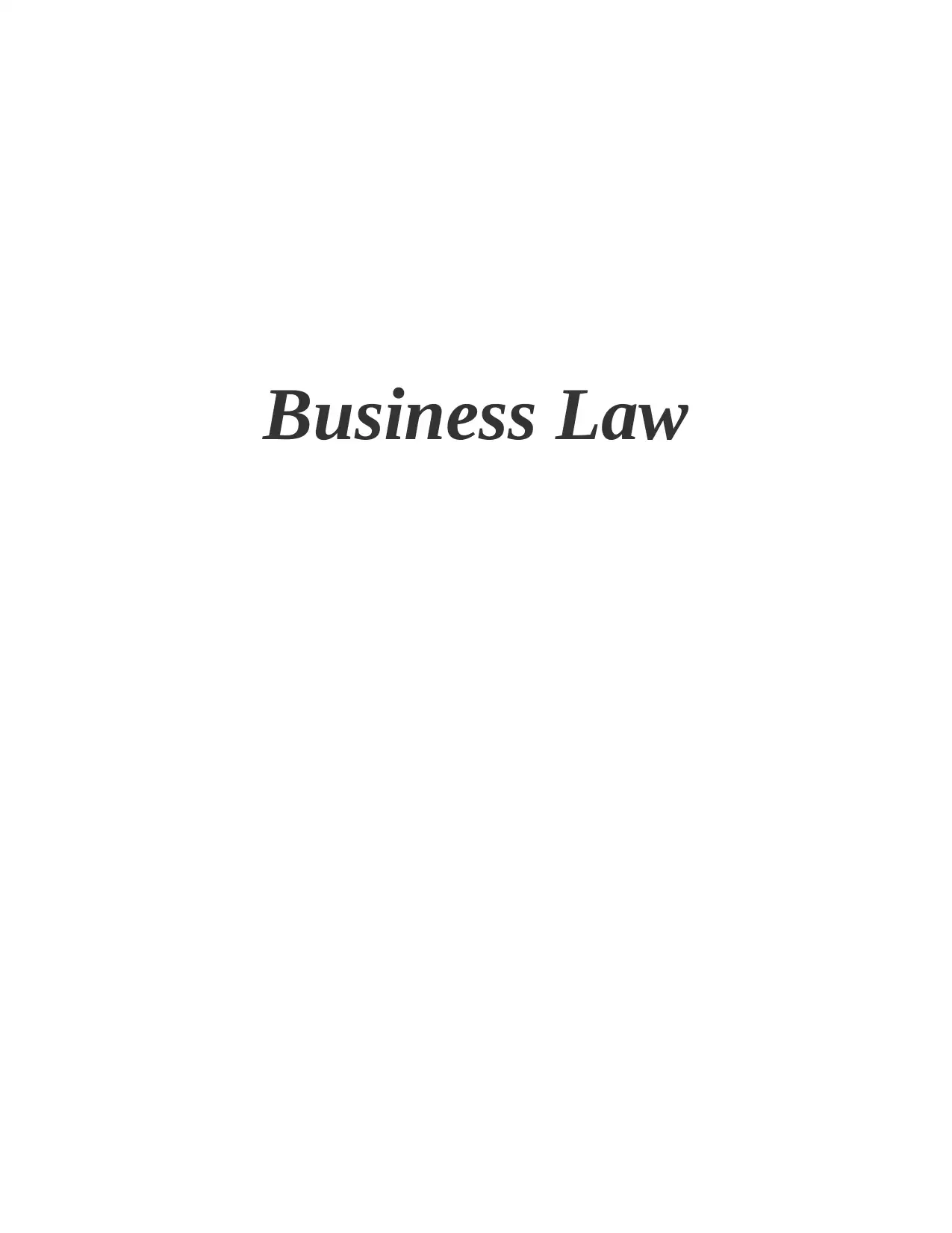
Business Law
Paraphrase This Document
Need a fresh take? Get an instant paraphrase of this document with our AI Paraphraser
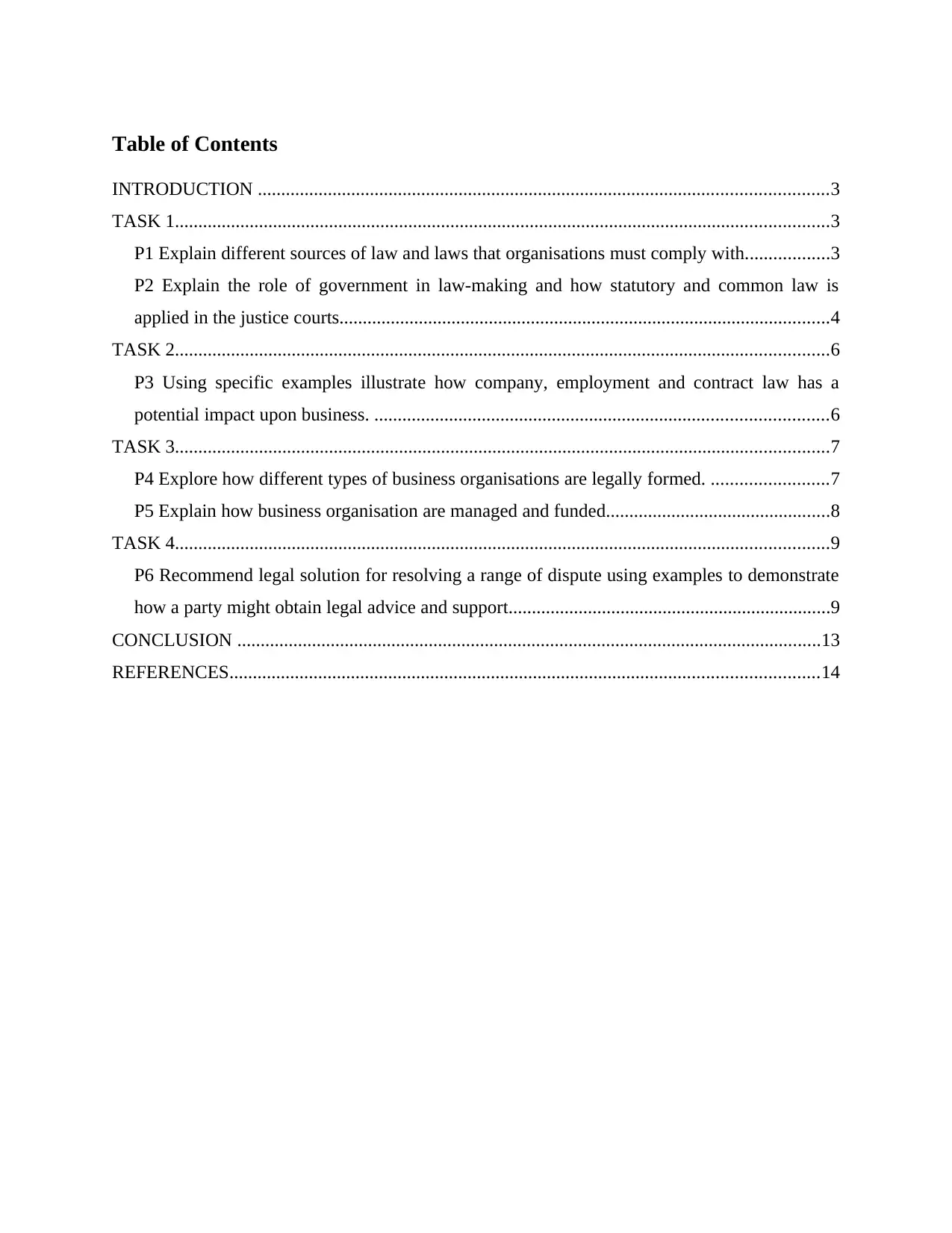
Table of Contents
INTRODUCTION ..........................................................................................................................3
TASK 1............................................................................................................................................3
P1 Explain different sources of law and laws that organisations must comply with..................3
P2 Explain the role of government in law-making and how statutory and common law is
applied in the justice courts.........................................................................................................4
TASK 2............................................................................................................................................6
P3 Using specific examples illustrate how company, employment and contract law has a
potential impact upon business. .................................................................................................6
TASK 3............................................................................................................................................7
P4 Explore how different types of business organisations are legally formed. .........................7
P5 Explain how business organisation are managed and funded................................................8
TASK 4............................................................................................................................................9
P6 Recommend legal solution for resolving a range of dispute using examples to demonstrate
how a party might obtain legal advice and support.....................................................................9
CONCLUSION .............................................................................................................................13
REFERENCES..............................................................................................................................14
INTRODUCTION ..........................................................................................................................3
TASK 1............................................................................................................................................3
P1 Explain different sources of law and laws that organisations must comply with..................3
P2 Explain the role of government in law-making and how statutory and common law is
applied in the justice courts.........................................................................................................4
TASK 2............................................................................................................................................6
P3 Using specific examples illustrate how company, employment and contract law has a
potential impact upon business. .................................................................................................6
TASK 3............................................................................................................................................7
P4 Explore how different types of business organisations are legally formed. .........................7
P5 Explain how business organisation are managed and funded................................................8
TASK 4............................................................................................................................................9
P6 Recommend legal solution for resolving a range of dispute using examples to demonstrate
how a party might obtain legal advice and support.....................................................................9
CONCLUSION .............................................................................................................................13
REFERENCES..............................................................................................................................14
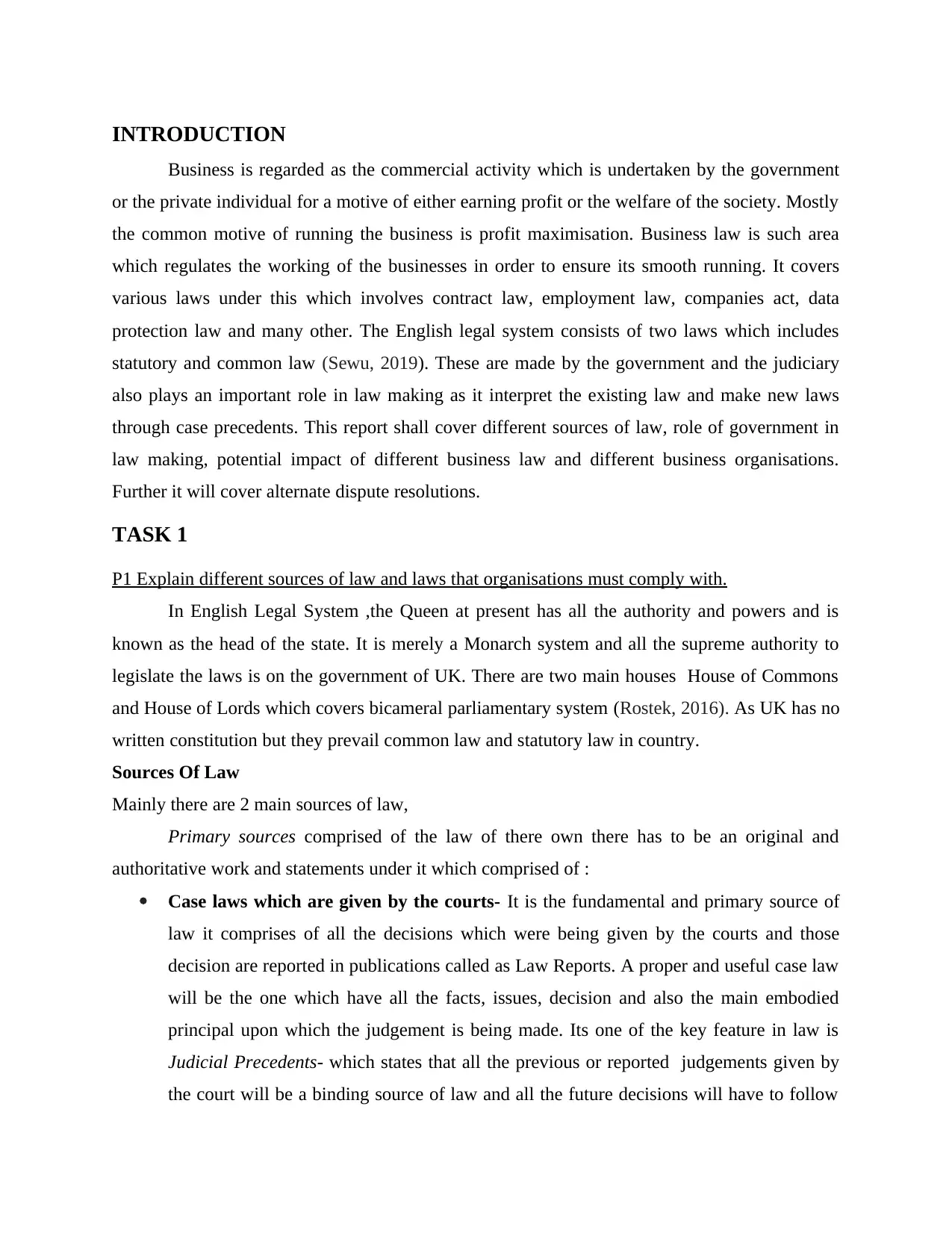
INTRODUCTION
Business is regarded as the commercial activity which is undertaken by the government
or the private individual for a motive of either earning profit or the welfare of the society. Mostly
the common motive of running the business is profit maximisation. Business law is such area
which regulates the working of the businesses in order to ensure its smooth running. It covers
various laws under this which involves contract law, employment law, companies act, data
protection law and many other. The English legal system consists of two laws which includes
statutory and common law (Sewu, 2019). These are made by the government and the judiciary
also plays an important role in law making as it interpret the existing law and make new laws
through case precedents. This report shall cover different sources of law, role of government in
law making, potential impact of different business law and different business organisations.
Further it will cover alternate dispute resolutions.
TASK 1
P1 Explain different sources of law and laws that organisations must comply with.
In English Legal System ,the Queen at present has all the authority and powers and is
known as the head of the state. It is merely a Monarch system and all the supreme authority to
legislate the laws is on the government of UK. There are two main houses House of Commons
and House of Lords which covers bicameral parliamentary system (Rostek, 2016). As UK has no
written constitution but they prevail common law and statutory law in country.
Sources Of Law
Mainly there are 2 main sources of law,
Primary sources comprised of the law of there own there has to be an original and
authoritative work and statements under it which comprised of :
Case laws which are given by the courts- It is the fundamental and primary source of
law it comprises of all the decisions which were being given by the courts and those
decision are reported in publications called as Law Reports. A proper and useful case law
will be the one which have all the facts, issues, decision and also the main embodied
principal upon which the judgement is being made. Its one of the key feature in law is
Judicial Precedents- which states that all the previous or reported judgements given by
the court will be a binding source of law and all the future decisions will have to follow
Business is regarded as the commercial activity which is undertaken by the government
or the private individual for a motive of either earning profit or the welfare of the society. Mostly
the common motive of running the business is profit maximisation. Business law is such area
which regulates the working of the businesses in order to ensure its smooth running. It covers
various laws under this which involves contract law, employment law, companies act, data
protection law and many other. The English legal system consists of two laws which includes
statutory and common law (Sewu, 2019). These are made by the government and the judiciary
also plays an important role in law making as it interpret the existing law and make new laws
through case precedents. This report shall cover different sources of law, role of government in
law making, potential impact of different business law and different business organisations.
Further it will cover alternate dispute resolutions.
TASK 1
P1 Explain different sources of law and laws that organisations must comply with.
In English Legal System ,the Queen at present has all the authority and powers and is
known as the head of the state. It is merely a Monarch system and all the supreme authority to
legislate the laws is on the government of UK. There are two main houses House of Commons
and House of Lords which covers bicameral parliamentary system (Rostek, 2016). As UK has no
written constitution but they prevail common law and statutory law in country.
Sources Of Law
Mainly there are 2 main sources of law,
Primary sources comprised of the law of there own there has to be an original and
authoritative work and statements under it which comprised of :
Case laws which are given by the courts- It is the fundamental and primary source of
law it comprises of all the decisions which were being given by the courts and those
decision are reported in publications called as Law Reports. A proper and useful case law
will be the one which have all the facts, issues, decision and also the main embodied
principal upon which the judgement is being made. Its one of the key feature in law is
Judicial Precedents- which states that all the previous or reported judgements given by
the court will be a binding source of law and all the future decisions will have to follow
⊘ This is a preview!⊘
Do you want full access?
Subscribe today to unlock all pages.

Trusted by 1+ million students worldwide
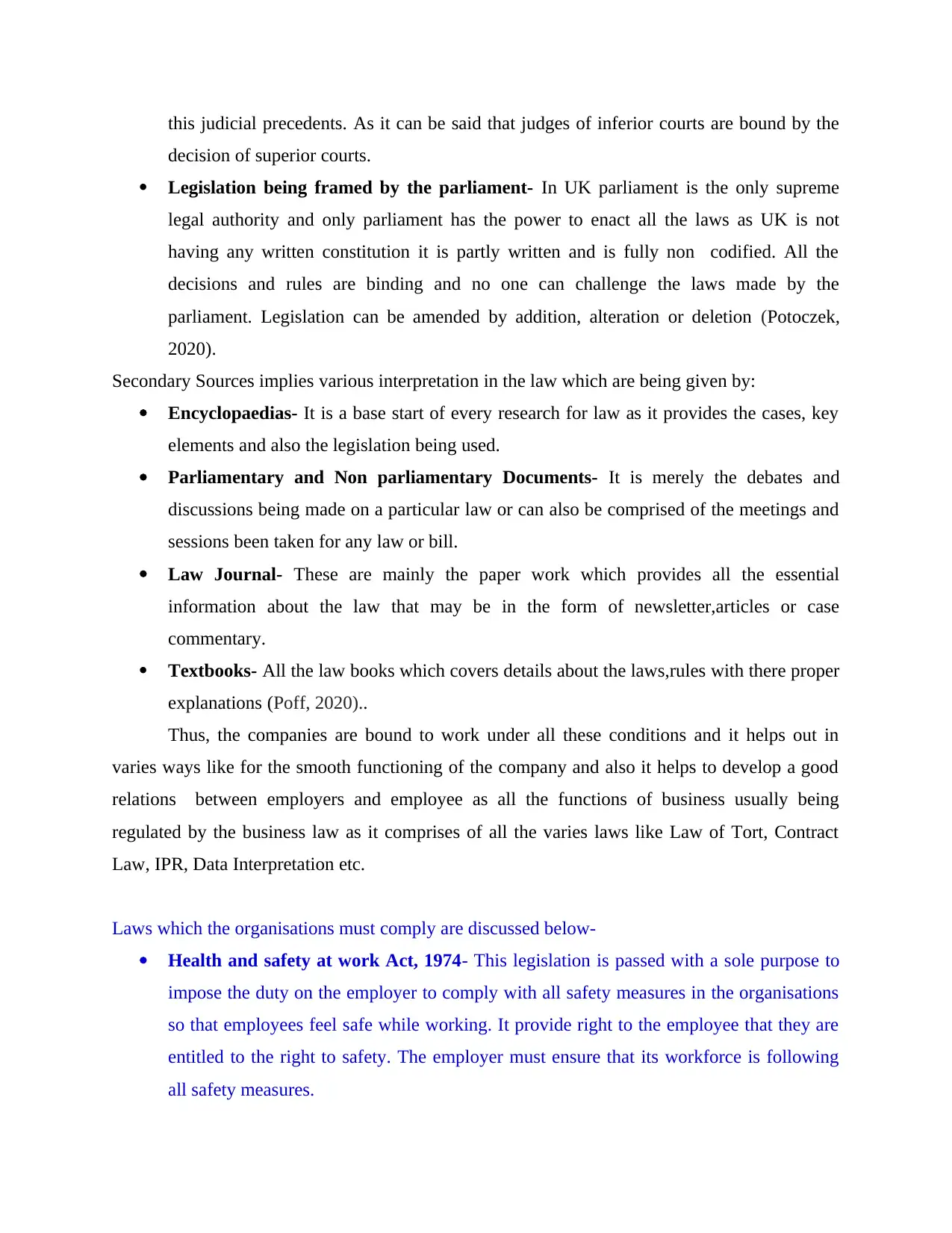
this judicial precedents. As it can be said that judges of inferior courts are bound by the
decision of superior courts.
Legislation being framed by the parliament- In UK parliament is the only supreme
legal authority and only parliament has the power to enact all the laws as UK is not
having any written constitution it is partly written and is fully non codified. All the
decisions and rules are binding and no one can challenge the laws made by the
parliament. Legislation can be amended by addition, alteration or deletion (Potoczek,
2020).
Secondary Sources implies various interpretation in the law which are being given by:
Encyclopaedias- It is a base start of every research for law as it provides the cases, key
elements and also the legislation being used.
Parliamentary and Non parliamentary Documents- It is merely the debates and
discussions being made on a particular law or can also be comprised of the meetings and
sessions been taken for any law or bill.
Law Journal- These are mainly the paper work which provides all the essential
information about the law that may be in the form of newsletter,articles or case
commentary.
Textbooks- All the law books which covers details about the laws,rules with there proper
explanations (Poff, 2020)..
Thus, the companies are bound to work under all these conditions and it helps out in
varies ways like for the smooth functioning of the company and also it helps to develop a good
relations between employers and employee as all the functions of business usually being
regulated by the business law as it comprises of all the varies laws like Law of Tort, Contract
Law, IPR, Data Interpretation etc.
Laws which the organisations must comply are discussed below-
Health and safety at work Act, 1974- This legislation is passed with a sole purpose to
impose the duty on the employer to comply with all safety measures in the organisations
so that employees feel safe while working. It provide right to the employee that they are
entitled to the right to safety. The employer must ensure that its workforce is following
all safety measures.
decision of superior courts.
Legislation being framed by the parliament- In UK parliament is the only supreme
legal authority and only parliament has the power to enact all the laws as UK is not
having any written constitution it is partly written and is fully non codified. All the
decisions and rules are binding and no one can challenge the laws made by the
parliament. Legislation can be amended by addition, alteration or deletion (Potoczek,
2020).
Secondary Sources implies various interpretation in the law which are being given by:
Encyclopaedias- It is a base start of every research for law as it provides the cases, key
elements and also the legislation being used.
Parliamentary and Non parliamentary Documents- It is merely the debates and
discussions being made on a particular law or can also be comprised of the meetings and
sessions been taken for any law or bill.
Law Journal- These are mainly the paper work which provides all the essential
information about the law that may be in the form of newsletter,articles or case
commentary.
Textbooks- All the law books which covers details about the laws,rules with there proper
explanations (Poff, 2020)..
Thus, the companies are bound to work under all these conditions and it helps out in
varies ways like for the smooth functioning of the company and also it helps to develop a good
relations between employers and employee as all the functions of business usually being
regulated by the business law as it comprises of all the varies laws like Law of Tort, Contract
Law, IPR, Data Interpretation etc.
Laws which the organisations must comply are discussed below-
Health and safety at work Act, 1974- This legislation is passed with a sole purpose to
impose the duty on the employer to comply with all safety measures in the organisations
so that employees feel safe while working. It provide right to the employee that they are
entitled to the right to safety. The employer must ensure that its workforce is following
all safety measures.
Paraphrase This Document
Need a fresh take? Get an instant paraphrase of this document with our AI Paraphraser
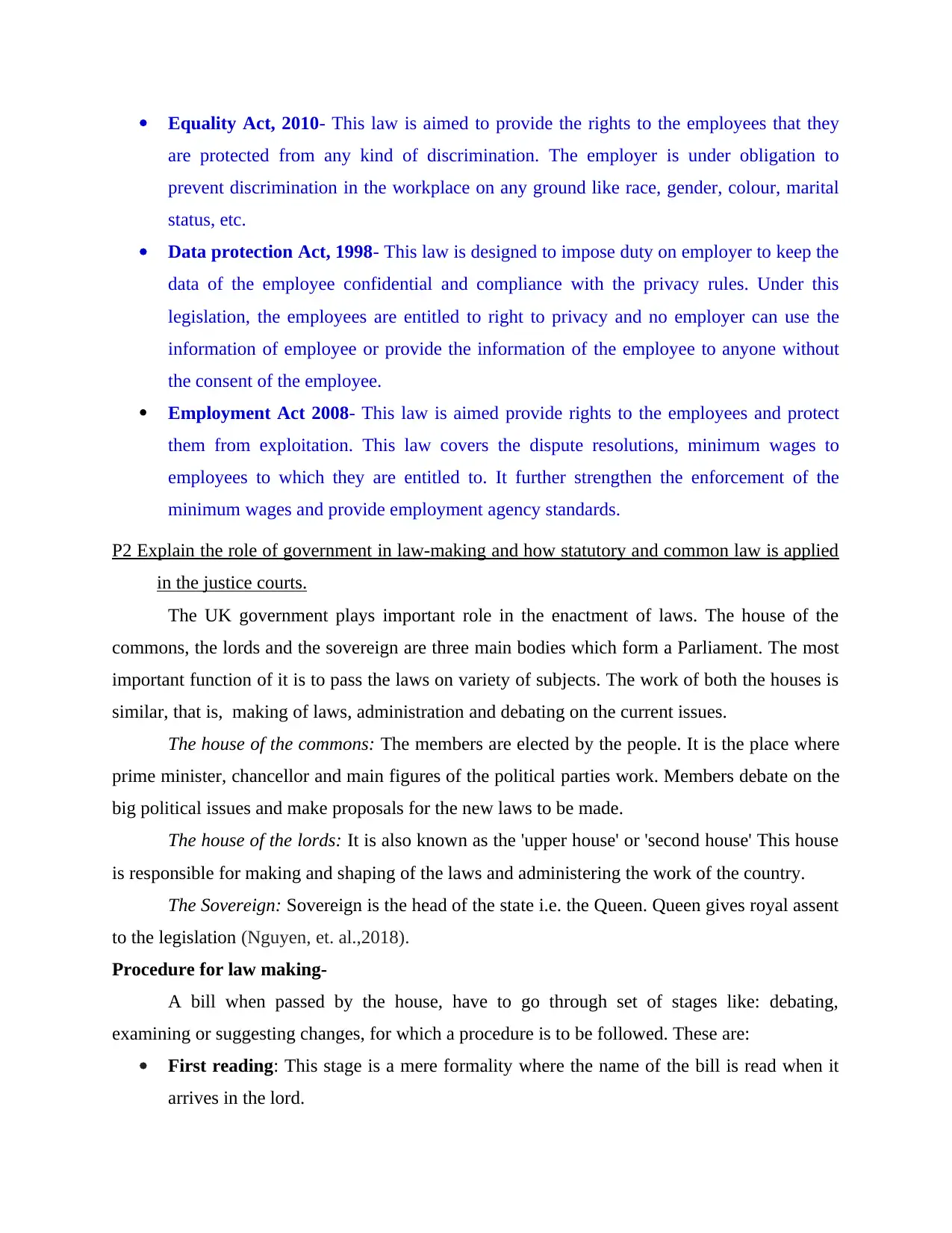
Equality Act, 2010- This law is aimed to provide the rights to the employees that they
are protected from any kind of discrimination. The employer is under obligation to
prevent discrimination in the workplace on any ground like race, gender, colour, marital
status, etc.
Data protection Act, 1998- This law is designed to impose duty on employer to keep the
data of the employee confidential and compliance with the privacy rules. Under this
legislation, the employees are entitled to right to privacy and no employer can use the
information of employee or provide the information of the employee to anyone without
the consent of the employee.
Employment Act 2008- This law is aimed provide rights to the employees and protect
them from exploitation. This law covers the dispute resolutions, minimum wages to
employees to which they are entitled to. It further strengthen the enforcement of the
minimum wages and provide employment agency standards.
P2 Explain the role of government in law-making and how statutory and common law is applied
in the justice courts.
The UK government plays important role in the enactment of laws. The house of the
commons, the lords and the sovereign are three main bodies which form a Parliament. The most
important function of it is to pass the laws on variety of subjects. The work of both the houses is
similar, that is, making of laws, administration and debating on the current issues.
The house of the commons: The members are elected by the people. It is the place where
prime minister, chancellor and main figures of the political parties work. Members debate on the
big political issues and make proposals for the new laws to be made.
The house of the lords: It is also known as the 'upper house' or 'second house' This house
is responsible for making and shaping of the laws and administering the work of the country.
The Sovereign: Sovereign is the head of the state i.e. the Queen. Queen gives royal assent
to the legislation (Nguyen, et. al.,2018).
Procedure for law making-
A bill when passed by the house, have to go through set of stages like: debating,
examining or suggesting changes, for which a procedure is to be followed. These are:
First reading: This stage is a mere formality where the name of the bill is read when it
arrives in the lord.
are protected from any kind of discrimination. The employer is under obligation to
prevent discrimination in the workplace on any ground like race, gender, colour, marital
status, etc.
Data protection Act, 1998- This law is designed to impose duty on employer to keep the
data of the employee confidential and compliance with the privacy rules. Under this
legislation, the employees are entitled to right to privacy and no employer can use the
information of employee or provide the information of the employee to anyone without
the consent of the employee.
Employment Act 2008- This law is aimed provide rights to the employees and protect
them from exploitation. This law covers the dispute resolutions, minimum wages to
employees to which they are entitled to. It further strengthen the enforcement of the
minimum wages and provide employment agency standards.
P2 Explain the role of government in law-making and how statutory and common law is applied
in the justice courts.
The UK government plays important role in the enactment of laws. The house of the
commons, the lords and the sovereign are three main bodies which form a Parliament. The most
important function of it is to pass the laws on variety of subjects. The work of both the houses is
similar, that is, making of laws, administration and debating on the current issues.
The house of the commons: The members are elected by the people. It is the place where
prime minister, chancellor and main figures of the political parties work. Members debate on the
big political issues and make proposals for the new laws to be made.
The house of the lords: It is also known as the 'upper house' or 'second house' This house
is responsible for making and shaping of the laws and administering the work of the country.
The Sovereign: Sovereign is the head of the state i.e. the Queen. Queen gives royal assent
to the legislation (Nguyen, et. al.,2018).
Procedure for law making-
A bill when passed by the house, have to go through set of stages like: debating,
examining or suggesting changes, for which a procedure is to be followed. These are:
First reading: This stage is a mere formality where the name of the bill is read when it
arrives in the lord.
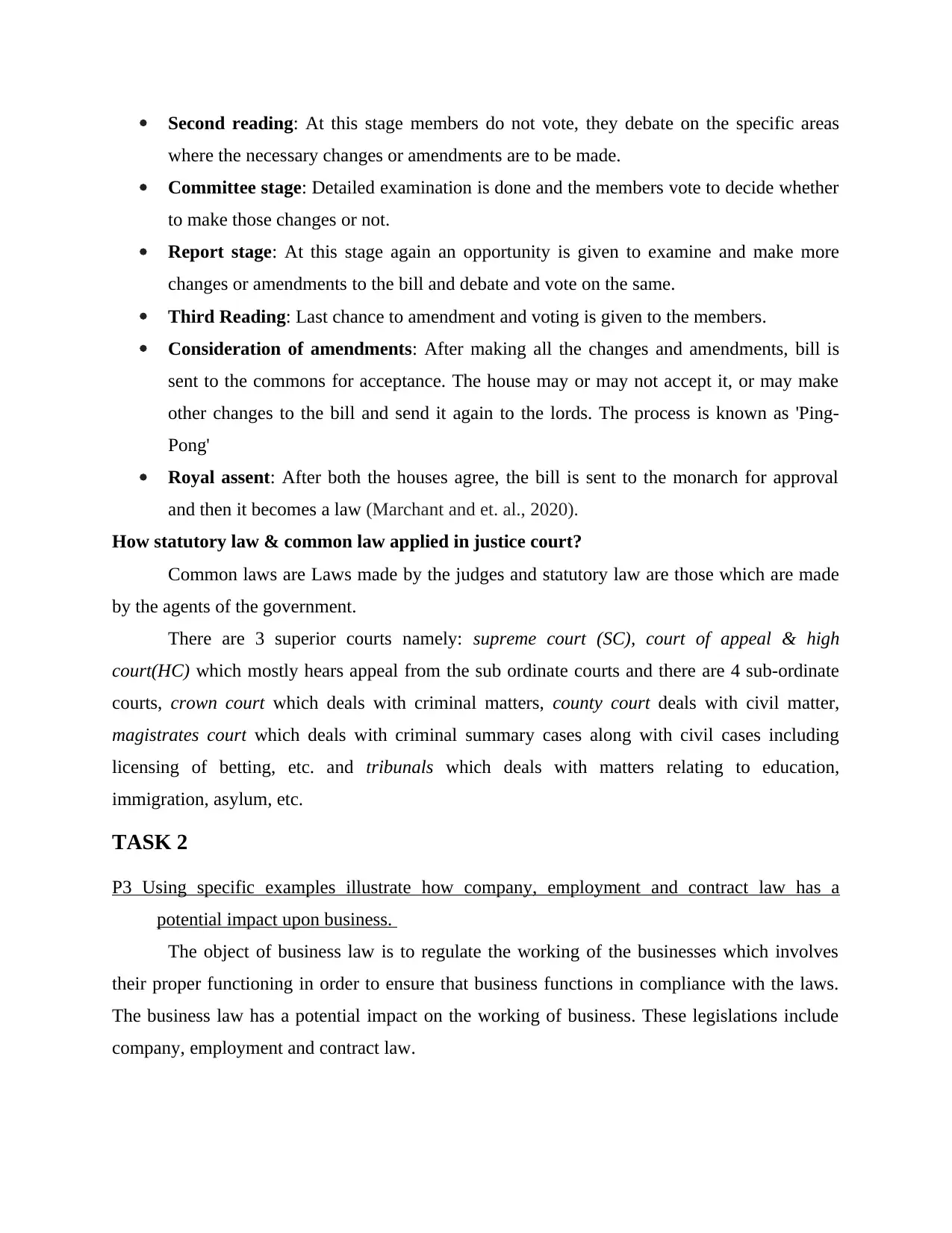
Second reading: At this stage members do not vote, they debate on the specific areas
where the necessary changes or amendments are to be made.
Committee stage: Detailed examination is done and the members vote to decide whether
to make those changes or not.
Report stage: At this stage again an opportunity is given to examine and make more
changes or amendments to the bill and debate and vote on the same.
Third Reading: Last chance to amendment and voting is given to the members.
Consideration of amendments: After making all the changes and amendments, bill is
sent to the commons for acceptance. The house may or may not accept it, or may make
other changes to the bill and send it again to the lords. The process is known as 'Ping-
Pong'
Royal assent: After both the houses agree, the bill is sent to the monarch for approval
and then it becomes a law (Marchant and et. al., 2020).
How statutory law & common law applied in justice court?
Common laws are Laws made by the judges and statutory law are those which are made
by the agents of the government.
There are 3 superior courts namely: supreme court (SC), court of appeal & high
court(HC) which mostly hears appeal from the sub ordinate courts and there are 4 sub-ordinate
courts, crown court which deals with criminal matters, county court deals with civil matter,
magistrates court which deals with criminal summary cases along with civil cases including
licensing of betting, etc. and tribunals which deals with matters relating to education,
immigration, asylum, etc.
TASK 2
P3 Using specific examples illustrate how company, employment and contract law has a
potential impact upon business.
The object of business law is to regulate the working of the businesses which involves
their proper functioning in order to ensure that business functions in compliance with the laws.
The business law has a potential impact on the working of business. These legislations include
company, employment and contract law.
where the necessary changes or amendments are to be made.
Committee stage: Detailed examination is done and the members vote to decide whether
to make those changes or not.
Report stage: At this stage again an opportunity is given to examine and make more
changes or amendments to the bill and debate and vote on the same.
Third Reading: Last chance to amendment and voting is given to the members.
Consideration of amendments: After making all the changes and amendments, bill is
sent to the commons for acceptance. The house may or may not accept it, or may make
other changes to the bill and send it again to the lords. The process is known as 'Ping-
Pong'
Royal assent: After both the houses agree, the bill is sent to the monarch for approval
and then it becomes a law (Marchant and et. al., 2020).
How statutory law & common law applied in justice court?
Common laws are Laws made by the judges and statutory law are those which are made
by the agents of the government.
There are 3 superior courts namely: supreme court (SC), court of appeal & high
court(HC) which mostly hears appeal from the sub ordinate courts and there are 4 sub-ordinate
courts, crown court which deals with criminal matters, county court deals with civil matter,
magistrates court which deals with criminal summary cases along with civil cases including
licensing of betting, etc. and tribunals which deals with matters relating to education,
immigration, asylum, etc.
TASK 2
P3 Using specific examples illustrate how company, employment and contract law has a
potential impact upon business.
The object of business law is to regulate the working of the businesses which involves
their proper functioning in order to ensure that business functions in compliance with the laws.
The business law has a potential impact on the working of business. These legislations include
company, employment and contract law.
⊘ This is a preview!⊘
Do you want full access?
Subscribe today to unlock all pages.

Trusted by 1+ million students worldwide
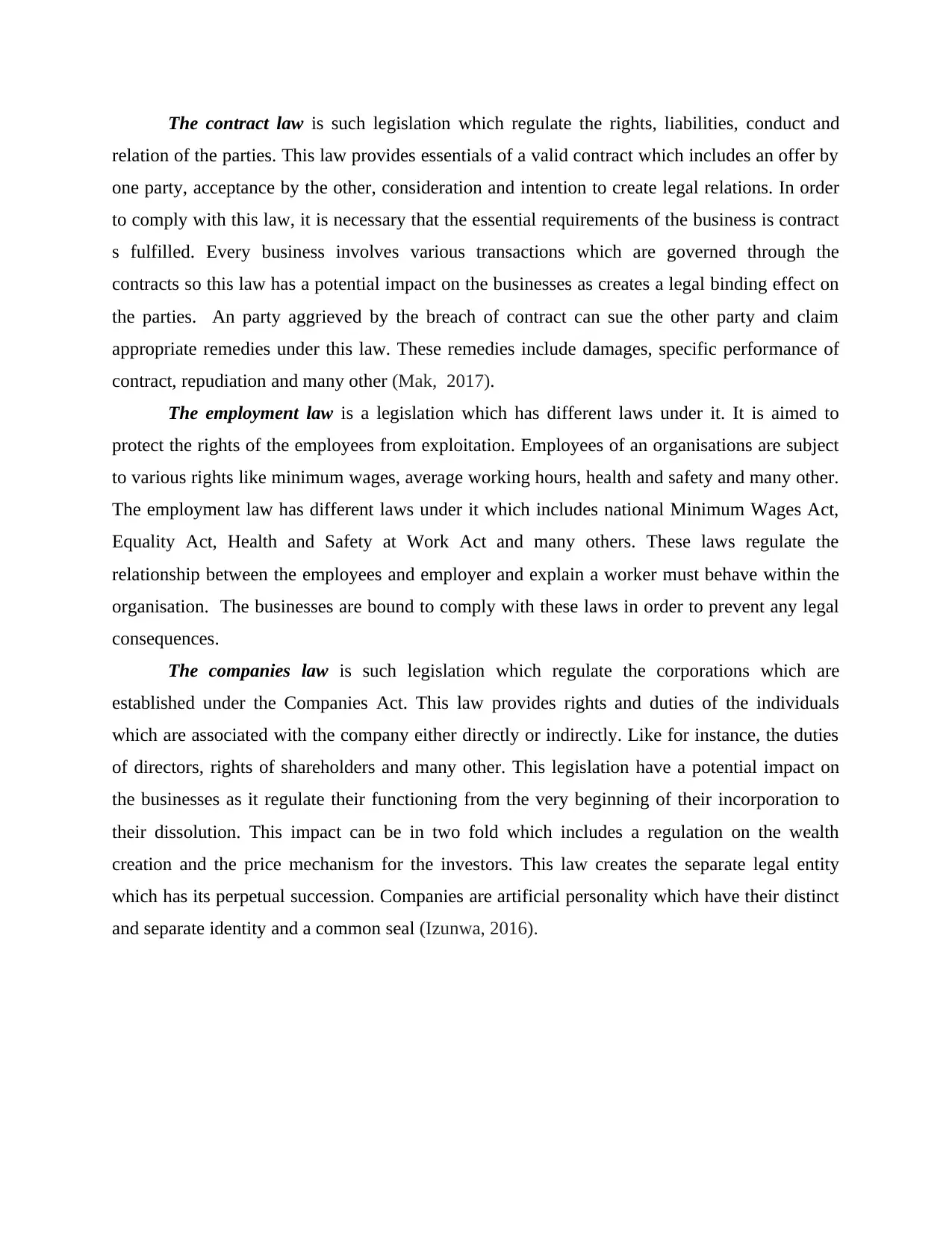
The contract law is such legislation which regulate the rights, liabilities, conduct and
relation of the parties. This law provides essentials of a valid contract which includes an offer by
one party, acceptance by the other, consideration and intention to create legal relations. In order
to comply with this law, it is necessary that the essential requirements of the business is contract
s fulfilled. Every business involves various transactions which are governed through the
contracts so this law has a potential impact on the businesses as creates a legal binding effect on
the parties. An party aggrieved by the breach of contract can sue the other party and claim
appropriate remedies under this law. These remedies include damages, specific performance of
contract, repudiation and many other (Mak, 2017).
The employment law is a legislation which has different laws under it. It is aimed to
protect the rights of the employees from exploitation. Employees of an organisations are subject
to various rights like minimum wages, average working hours, health and safety and many other.
The employment law has different laws under it which includes national Minimum Wages Act,
Equality Act, Health and Safety at Work Act and many others. These laws regulate the
relationship between the employees and employer and explain a worker must behave within the
organisation. The businesses are bound to comply with these laws in order to prevent any legal
consequences.
The companies law is such legislation which regulate the corporations which are
established under the Companies Act. This law provides rights and duties of the individuals
which are associated with the company either directly or indirectly. Like for instance, the duties
of directors, rights of shareholders and many other. This legislation have a potential impact on
the businesses as it regulate their functioning from the very beginning of their incorporation to
their dissolution. This impact can be in two fold which includes a regulation on the wealth
creation and the price mechanism for the investors. This law creates the separate legal entity
which has its perpetual succession. Companies are artificial personality which have their distinct
and separate identity and a common seal (Izunwa, 2016).
relation of the parties. This law provides essentials of a valid contract which includes an offer by
one party, acceptance by the other, consideration and intention to create legal relations. In order
to comply with this law, it is necessary that the essential requirements of the business is contract
s fulfilled. Every business involves various transactions which are governed through the
contracts so this law has a potential impact on the businesses as creates a legal binding effect on
the parties. An party aggrieved by the breach of contract can sue the other party and claim
appropriate remedies under this law. These remedies include damages, specific performance of
contract, repudiation and many other (Mak, 2017).
The employment law is a legislation which has different laws under it. It is aimed to
protect the rights of the employees from exploitation. Employees of an organisations are subject
to various rights like minimum wages, average working hours, health and safety and many other.
The employment law has different laws under it which includes national Minimum Wages Act,
Equality Act, Health and Safety at Work Act and many others. These laws regulate the
relationship between the employees and employer and explain a worker must behave within the
organisation. The businesses are bound to comply with these laws in order to prevent any legal
consequences.
The companies law is such legislation which regulate the corporations which are
established under the Companies Act. This law provides rights and duties of the individuals
which are associated with the company either directly or indirectly. Like for instance, the duties
of directors, rights of shareholders and many other. This legislation have a potential impact on
the businesses as it regulate their functioning from the very beginning of their incorporation to
their dissolution. This impact can be in two fold which includes a regulation on the wealth
creation and the price mechanism for the investors. This law creates the separate legal entity
which has its perpetual succession. Companies are artificial personality which have their distinct
and separate identity and a common seal (Izunwa, 2016).
Paraphrase This Document
Need a fresh take? Get an instant paraphrase of this document with our AI Paraphraser
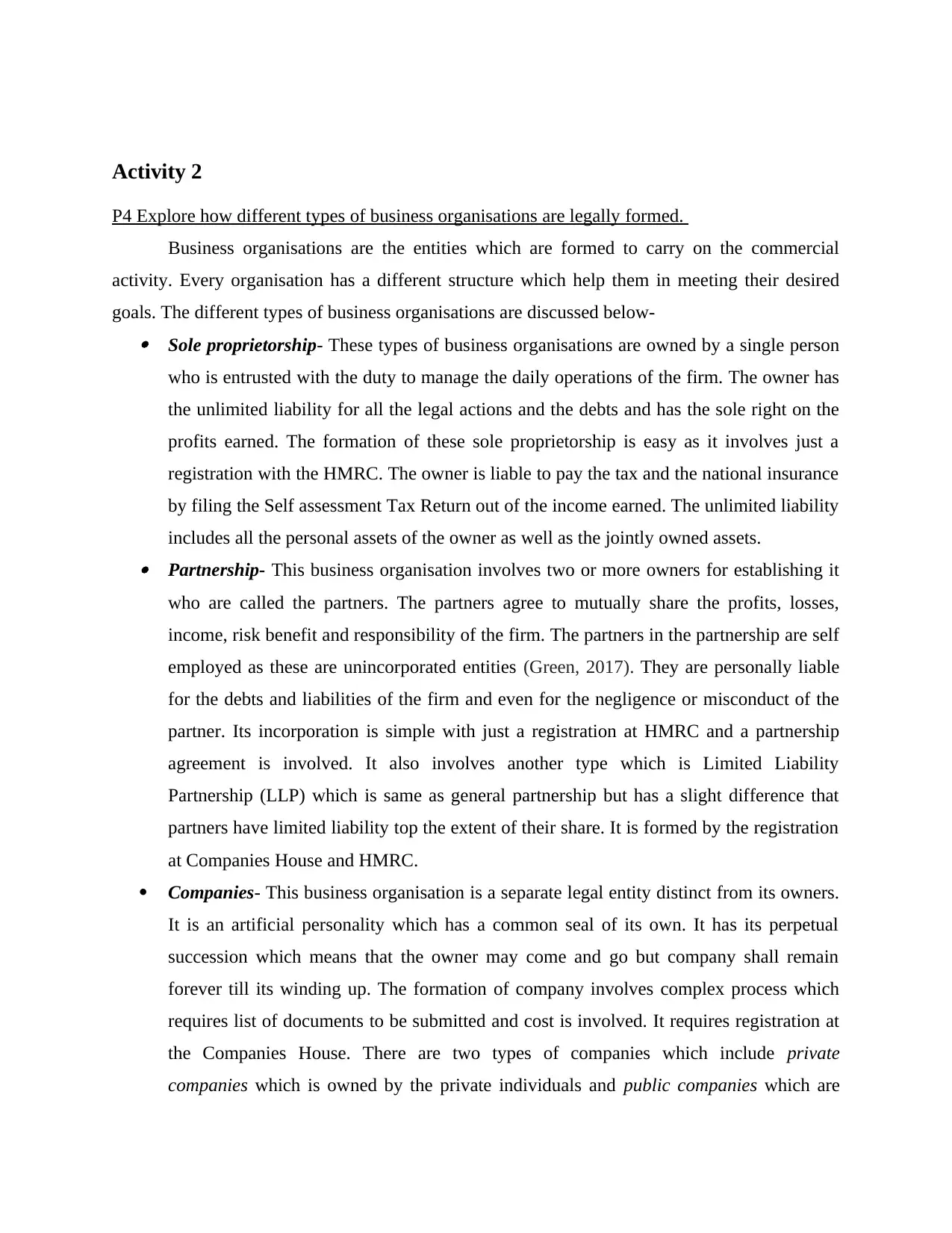
Activity 2
P4 Explore how different types of business organisations are legally formed.
Business organisations are the entities which are formed to carry on the commercial
activity. Every organisation has a different structure which help them in meeting their desired
goals. The different types of business organisations are discussed below- Sole proprietorship- These types of business organisations are owned by a single person
who is entrusted with the duty to manage the daily operations of the firm. The owner has
the unlimited liability for all the legal actions and the debts and has the sole right on the
profits earned. The formation of these sole proprietorship is easy as it involves just a
registration with the HMRC. The owner is liable to pay the tax and the national insurance
by filing the Self assessment Tax Return out of the income earned. The unlimited liability
includes all the personal assets of the owner as well as the jointly owned assets. Partnership- This business organisation involves two or more owners for establishing it
who are called the partners. The partners agree to mutually share the profits, losses,
income, risk benefit and responsibility of the firm. The partners in the partnership are self
employed as these are unincorporated entities (Green, 2017). They are personally liable
for the debts and liabilities of the firm and even for the negligence or misconduct of the
partner. Its incorporation is simple with just a registration at HMRC and a partnership
agreement is involved. It also involves another type which is Limited Liability
Partnership (LLP) which is same as general partnership but has a slight difference that
partners have limited liability top the extent of their share. It is formed by the registration
at Companies House and HMRC.
Companies- This business organisation is a separate legal entity distinct from its owners.
It is an artificial personality which has a common seal of its own. It has its perpetual
succession which means that the owner may come and go but company shall remain
forever till its winding up. The formation of company involves complex process which
requires list of documents to be submitted and cost is involved. It requires registration at
the Companies House. There are two types of companies which include private
companies which is owned by the private individuals and public companies which are
P4 Explore how different types of business organisations are legally formed.
Business organisations are the entities which are formed to carry on the commercial
activity. Every organisation has a different structure which help them in meeting their desired
goals. The different types of business organisations are discussed below- Sole proprietorship- These types of business organisations are owned by a single person
who is entrusted with the duty to manage the daily operations of the firm. The owner has
the unlimited liability for all the legal actions and the debts and has the sole right on the
profits earned. The formation of these sole proprietorship is easy as it involves just a
registration with the HMRC. The owner is liable to pay the tax and the national insurance
by filing the Self assessment Tax Return out of the income earned. The unlimited liability
includes all the personal assets of the owner as well as the jointly owned assets. Partnership- This business organisation involves two or more owners for establishing it
who are called the partners. The partners agree to mutually share the profits, losses,
income, risk benefit and responsibility of the firm. The partners in the partnership are self
employed as these are unincorporated entities (Green, 2017). They are personally liable
for the debts and liabilities of the firm and even for the negligence or misconduct of the
partner. Its incorporation is simple with just a registration at HMRC and a partnership
agreement is involved. It also involves another type which is Limited Liability
Partnership (LLP) which is same as general partnership but has a slight difference that
partners have limited liability top the extent of their share. It is formed by the registration
at Companies House and HMRC.
Companies- This business organisation is a separate legal entity distinct from its owners.
It is an artificial personality which has a common seal of its own. It has its perpetual
succession which means that the owner may come and go but company shall remain
forever till its winding up. The formation of company involves complex process which
requires list of documents to be submitted and cost is involved. It requires registration at
the Companies House. There are two types of companies which include private
companies which is owned by the private individuals and public companies which are
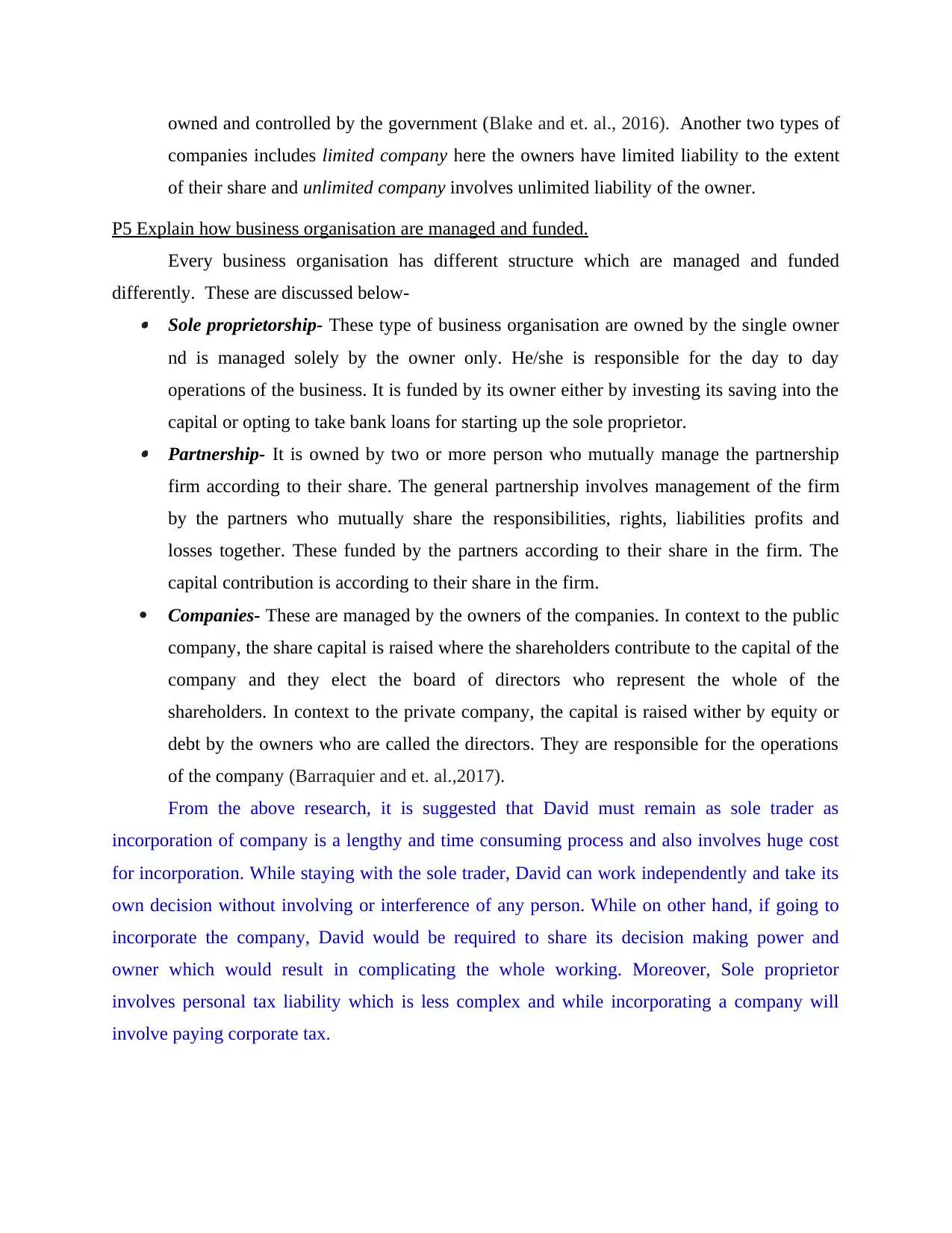
owned and controlled by the government (Blake and et. al., 2016). Another two types of
companies includes limited company here the owners have limited liability to the extent
of their share and unlimited company involves unlimited liability of the owner.
P5 Explain how business organisation are managed and funded.
Every business organisation has different structure which are managed and funded
differently. These are discussed below- Sole proprietorship- These type of business organisation are owned by the single owner
nd is managed solely by the owner only. He/she is responsible for the day to day
operations of the business. It is funded by its owner either by investing its saving into the
capital or opting to take bank loans for starting up the sole proprietor. Partnership- It is owned by two or more person who mutually manage the partnership
firm according to their share. The general partnership involves management of the firm
by the partners who mutually share the responsibilities, rights, liabilities profits and
losses together. These funded by the partners according to their share in the firm. The
capital contribution is according to their share in the firm.
Companies- These are managed by the owners of the companies. In context to the public
company, the share capital is raised where the shareholders contribute to the capital of the
company and they elect the board of directors who represent the whole of the
shareholders. In context to the private company, the capital is raised wither by equity or
debt by the owners who are called the directors. They are responsible for the operations
of the company (Barraquier and et. al.,2017).
From the above research, it is suggested that David must remain as sole trader as
incorporation of company is a lengthy and time consuming process and also involves huge cost
for incorporation. While staying with the sole trader, David can work independently and take its
own decision without involving or interference of any person. While on other hand, if going to
incorporate the company, David would be required to share its decision making power and
owner which would result in complicating the whole working. Moreover, Sole proprietor
involves personal tax liability which is less complex and while incorporating a company will
involve paying corporate tax.
companies includes limited company here the owners have limited liability to the extent
of their share and unlimited company involves unlimited liability of the owner.
P5 Explain how business organisation are managed and funded.
Every business organisation has different structure which are managed and funded
differently. These are discussed below- Sole proprietorship- These type of business organisation are owned by the single owner
nd is managed solely by the owner only. He/she is responsible for the day to day
operations of the business. It is funded by its owner either by investing its saving into the
capital or opting to take bank loans for starting up the sole proprietor. Partnership- It is owned by two or more person who mutually manage the partnership
firm according to their share. The general partnership involves management of the firm
by the partners who mutually share the responsibilities, rights, liabilities profits and
losses together. These funded by the partners according to their share in the firm. The
capital contribution is according to their share in the firm.
Companies- These are managed by the owners of the companies. In context to the public
company, the share capital is raised where the shareholders contribute to the capital of the
company and they elect the board of directors who represent the whole of the
shareholders. In context to the private company, the capital is raised wither by equity or
debt by the owners who are called the directors. They are responsible for the operations
of the company (Barraquier and et. al.,2017).
From the above research, it is suggested that David must remain as sole trader as
incorporation of company is a lengthy and time consuming process and also involves huge cost
for incorporation. While staying with the sole trader, David can work independently and take its
own decision without involving or interference of any person. While on other hand, if going to
incorporate the company, David would be required to share its decision making power and
owner which would result in complicating the whole working. Moreover, Sole proprietor
involves personal tax liability which is less complex and while incorporating a company will
involve paying corporate tax.
⊘ This is a preview!⊘
Do you want full access?
Subscribe today to unlock all pages.

Trusted by 1+ million students worldwide
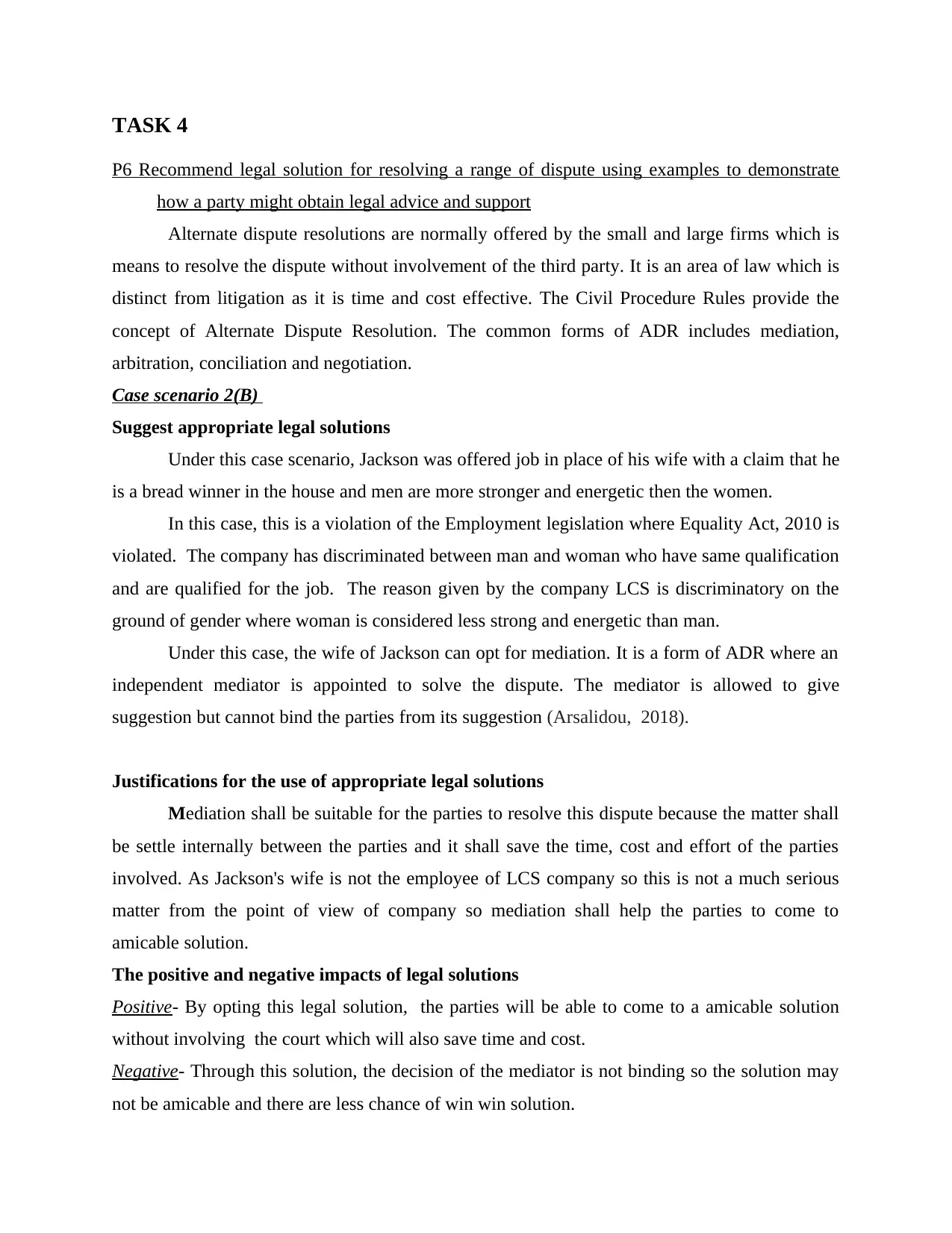
TASK 4
P6 Recommend legal solution for resolving a range of dispute using examples to demonstrate
how a party might obtain legal advice and support
Alternate dispute resolutions are normally offered by the small and large firms which is
means to resolve the dispute without involvement of the third party. It is an area of law which is
distinct from litigation as it is time and cost effective. The Civil Procedure Rules provide the
concept of Alternate Dispute Resolution. The common forms of ADR includes mediation,
arbitration, conciliation and negotiation.
Case scenario 2(B)
Suggest appropriate legal solutions
Under this case scenario, Jackson was offered job in place of his wife with a claim that he
is a bread winner in the house and men are more stronger and energetic then the women.
In this case, this is a violation of the Employment legislation where Equality Act, 2010 is
violated. The company has discriminated between man and woman who have same qualification
and are qualified for the job. The reason given by the company LCS is discriminatory on the
ground of gender where woman is considered less strong and energetic than man.
Under this case, the wife of Jackson can opt for mediation. It is a form of ADR where an
independent mediator is appointed to solve the dispute. The mediator is allowed to give
suggestion but cannot bind the parties from its suggestion (Arsalidou, 2018).
Justifications for the use of appropriate legal solutions
Mediation shall be suitable for the parties to resolve this dispute because the matter shall
be settle internally between the parties and it shall save the time, cost and effort of the parties
involved. As Jackson's wife is not the employee of LCS company so this is not a much serious
matter from the point of view of company so mediation shall help the parties to come to
amicable solution.
The positive and negative impacts of legal solutions
Positive- By opting this legal solution, the parties will be able to come to a amicable solution
without involving the court which will also save time and cost.
Negative- Through this solution, the decision of the mediator is not binding so the solution may
not be amicable and there are less chance of win win solution.
P6 Recommend legal solution for resolving a range of dispute using examples to demonstrate
how a party might obtain legal advice and support
Alternate dispute resolutions are normally offered by the small and large firms which is
means to resolve the dispute without involvement of the third party. It is an area of law which is
distinct from litigation as it is time and cost effective. The Civil Procedure Rules provide the
concept of Alternate Dispute Resolution. The common forms of ADR includes mediation,
arbitration, conciliation and negotiation.
Case scenario 2(B)
Suggest appropriate legal solutions
Under this case scenario, Jackson was offered job in place of his wife with a claim that he
is a bread winner in the house and men are more stronger and energetic then the women.
In this case, this is a violation of the Employment legislation where Equality Act, 2010 is
violated. The company has discriminated between man and woman who have same qualification
and are qualified for the job. The reason given by the company LCS is discriminatory on the
ground of gender where woman is considered less strong and energetic than man.
Under this case, the wife of Jackson can opt for mediation. It is a form of ADR where an
independent mediator is appointed to solve the dispute. The mediator is allowed to give
suggestion but cannot bind the parties from its suggestion (Arsalidou, 2018).
Justifications for the use of appropriate legal solutions
Mediation shall be suitable for the parties to resolve this dispute because the matter shall
be settle internally between the parties and it shall save the time, cost and effort of the parties
involved. As Jackson's wife is not the employee of LCS company so this is not a much serious
matter from the point of view of company so mediation shall help the parties to come to
amicable solution.
The positive and negative impacts of legal solutions
Positive- By opting this legal solution, the parties will be able to come to a amicable solution
without involving the court which will also save time and cost.
Negative- Through this solution, the decision of the mediator is not binding so the solution may
not be amicable and there are less chance of win win solution.
Paraphrase This Document
Need a fresh take? Get an instant paraphrase of this document with our AI Paraphraser
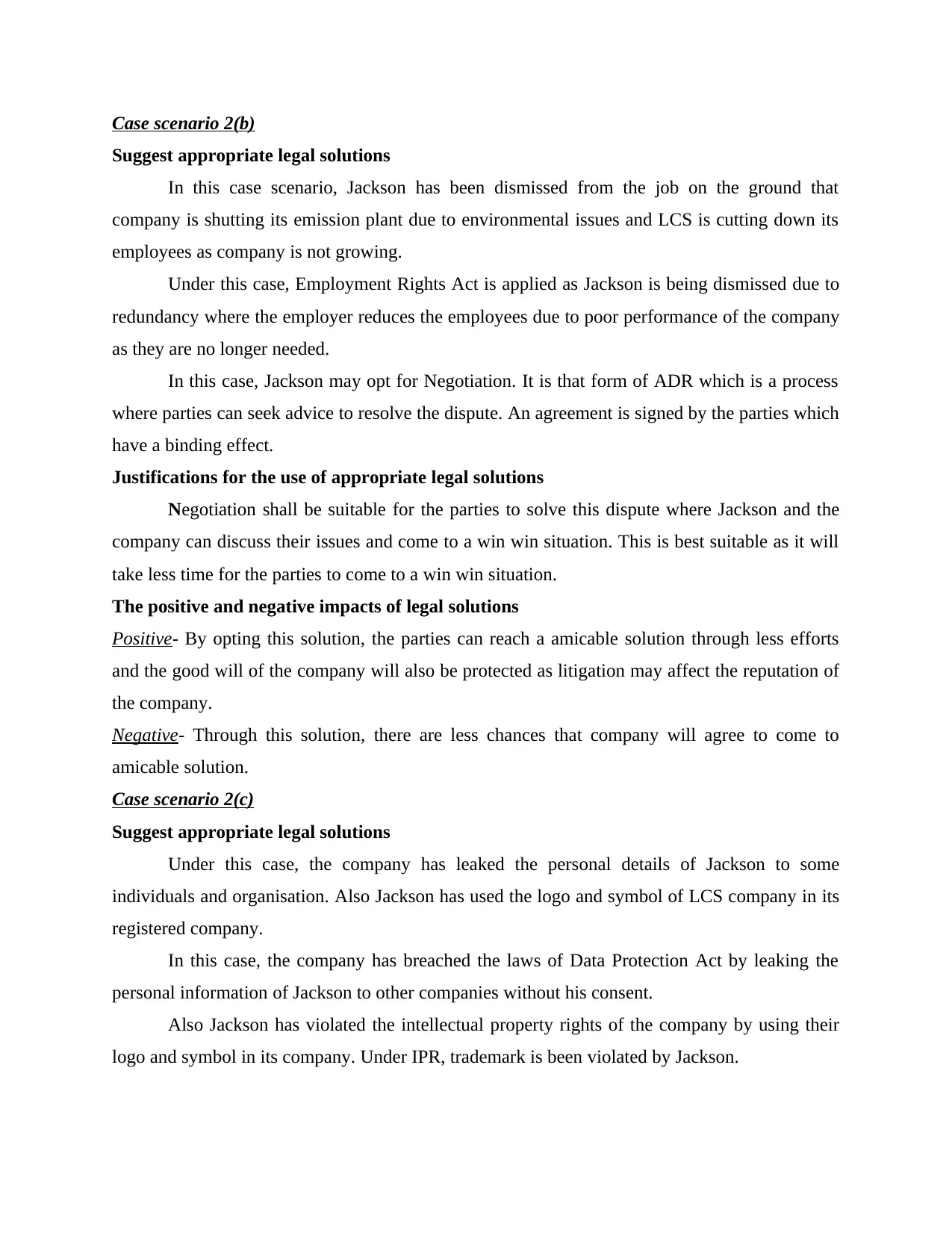
Case scenario 2(b)
Suggest appropriate legal solutions
In this case scenario, Jackson has been dismissed from the job on the ground that
company is shutting its emission plant due to environmental issues and LCS is cutting down its
employees as company is not growing.
Under this case, Employment Rights Act is applied as Jackson is being dismissed due to
redundancy where the employer reduces the employees due to poor performance of the company
as they are no longer needed.
In this case, Jackson may opt for Negotiation. It is that form of ADR which is a process
where parties can seek advice to resolve the dispute. An agreement is signed by the parties which
have a binding effect.
Justifications for the use of appropriate legal solutions
Negotiation shall be suitable for the parties to solve this dispute where Jackson and the
company can discuss their issues and come to a win win situation. This is best suitable as it will
take less time for the parties to come to a win win situation.
The positive and negative impacts of legal solutions
Positive- By opting this solution, the parties can reach a amicable solution through less efforts
and the good will of the company will also be protected as litigation may affect the reputation of
the company.
Negative- Through this solution, there are less chances that company will agree to come to
amicable solution.
Case scenario 2(c)
Suggest appropriate legal solutions
Under this case, the company has leaked the personal details of Jackson to some
individuals and organisation. Also Jackson has used the logo and symbol of LCS company in its
registered company.
In this case, the company has breached the laws of Data Protection Act by leaking the
personal information of Jackson to other companies without his consent.
Also Jackson has violated the intellectual property rights of the company by using their
logo and symbol in its company. Under IPR, trademark is been violated by Jackson.
Suggest appropriate legal solutions
In this case scenario, Jackson has been dismissed from the job on the ground that
company is shutting its emission plant due to environmental issues and LCS is cutting down its
employees as company is not growing.
Under this case, Employment Rights Act is applied as Jackson is being dismissed due to
redundancy where the employer reduces the employees due to poor performance of the company
as they are no longer needed.
In this case, Jackson may opt for Negotiation. It is that form of ADR which is a process
where parties can seek advice to resolve the dispute. An agreement is signed by the parties which
have a binding effect.
Justifications for the use of appropriate legal solutions
Negotiation shall be suitable for the parties to solve this dispute where Jackson and the
company can discuss their issues and come to a win win situation. This is best suitable as it will
take less time for the parties to come to a win win situation.
The positive and negative impacts of legal solutions
Positive- By opting this solution, the parties can reach a amicable solution through less efforts
and the good will of the company will also be protected as litigation may affect the reputation of
the company.
Negative- Through this solution, there are less chances that company will agree to come to
amicable solution.
Case scenario 2(c)
Suggest appropriate legal solutions
Under this case, the company has leaked the personal details of Jackson to some
individuals and organisation. Also Jackson has used the logo and symbol of LCS company in its
registered company.
In this case, the company has breached the laws of Data Protection Act by leaking the
personal information of Jackson to other companies without his consent.
Also Jackson has violated the intellectual property rights of the company by using their
logo and symbol in its company. Under IPR, trademark is been violated by Jackson.
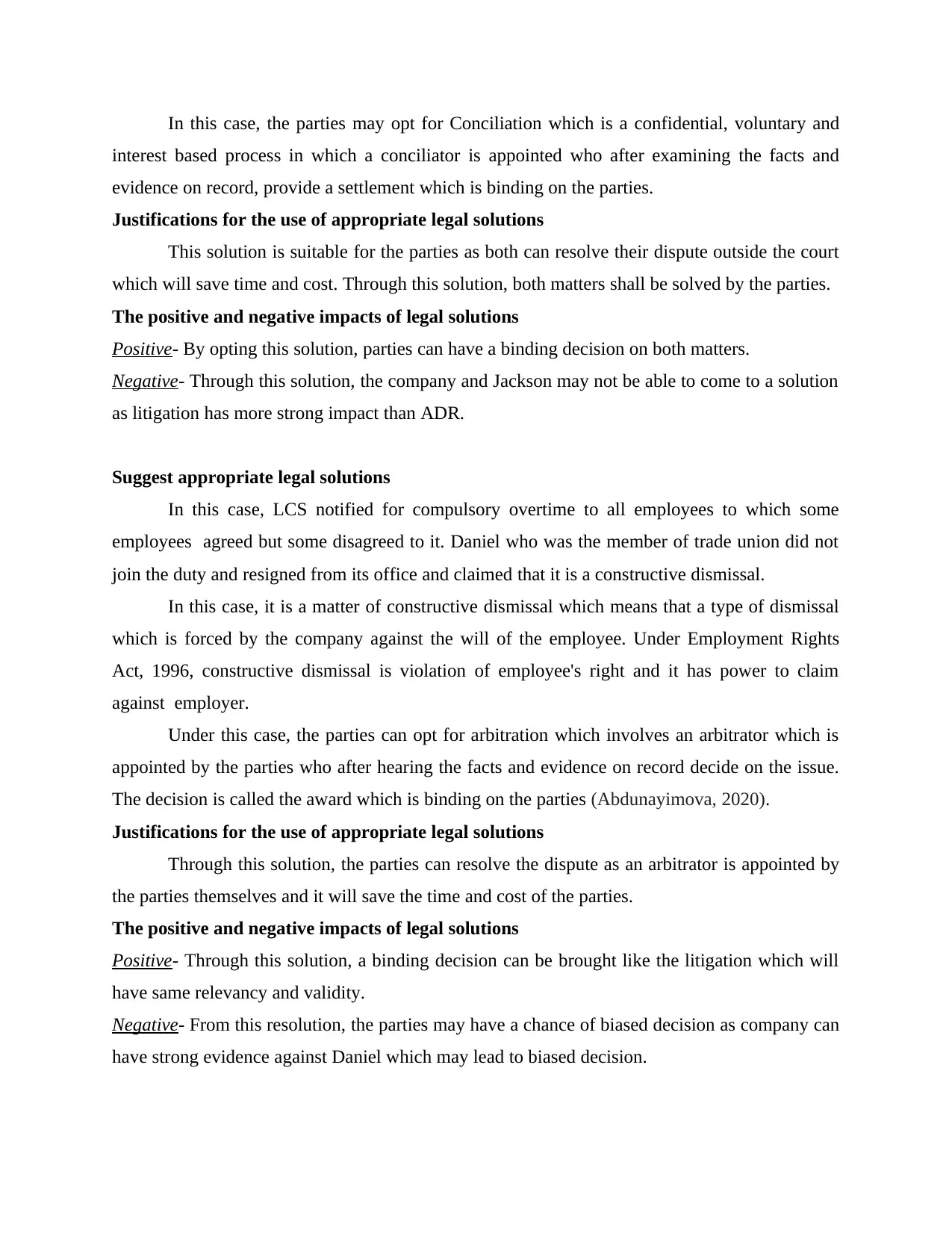
In this case, the parties may opt for Conciliation which is a confidential, voluntary and
interest based process in which a conciliator is appointed who after examining the facts and
evidence on record, provide a settlement which is binding on the parties.
Justifications for the use of appropriate legal solutions
This solution is suitable for the parties as both can resolve their dispute outside the court
which will save time and cost. Through this solution, both matters shall be solved by the parties.
The positive and negative impacts of legal solutions
Positive- By opting this solution, parties can have a binding decision on both matters.
Negative- Through this solution, the company and Jackson may not be able to come to a solution
as litigation has more strong impact than ADR.
Suggest appropriate legal solutions
In this case, LCS notified for compulsory overtime to all employees to which some
employees agreed but some disagreed to it. Daniel who was the member of trade union did not
join the duty and resigned from its office and claimed that it is a constructive dismissal.
In this case, it is a matter of constructive dismissal which means that a type of dismissal
which is forced by the company against the will of the employee. Under Employment Rights
Act, 1996, constructive dismissal is violation of employee's right and it has power to claim
against employer.
Under this case, the parties can opt for arbitration which involves an arbitrator which is
appointed by the parties who after hearing the facts and evidence on record decide on the issue.
The decision is called the award which is binding on the parties (Abdunayimova, 2020).
Justifications for the use of appropriate legal solutions
Through this solution, the parties can resolve the dispute as an arbitrator is appointed by
the parties themselves and it will save the time and cost of the parties.
The positive and negative impacts of legal solutions
Positive- Through this solution, a binding decision can be brought like the litigation which will
have same relevancy and validity.
Negative- From this resolution, the parties may have a chance of biased decision as company can
have strong evidence against Daniel which may lead to biased decision.
interest based process in which a conciliator is appointed who after examining the facts and
evidence on record, provide a settlement which is binding on the parties.
Justifications for the use of appropriate legal solutions
This solution is suitable for the parties as both can resolve their dispute outside the court
which will save time and cost. Through this solution, both matters shall be solved by the parties.
The positive and negative impacts of legal solutions
Positive- By opting this solution, parties can have a binding decision on both matters.
Negative- Through this solution, the company and Jackson may not be able to come to a solution
as litigation has more strong impact than ADR.
Suggest appropriate legal solutions
In this case, LCS notified for compulsory overtime to all employees to which some
employees agreed but some disagreed to it. Daniel who was the member of trade union did not
join the duty and resigned from its office and claimed that it is a constructive dismissal.
In this case, it is a matter of constructive dismissal which means that a type of dismissal
which is forced by the company against the will of the employee. Under Employment Rights
Act, 1996, constructive dismissal is violation of employee's right and it has power to claim
against employer.
Under this case, the parties can opt for arbitration which involves an arbitrator which is
appointed by the parties who after hearing the facts and evidence on record decide on the issue.
The decision is called the award which is binding on the parties (Abdunayimova, 2020).
Justifications for the use of appropriate legal solutions
Through this solution, the parties can resolve the dispute as an arbitrator is appointed by
the parties themselves and it will save the time and cost of the parties.
The positive and negative impacts of legal solutions
Positive- Through this solution, a binding decision can be brought like the litigation which will
have same relevancy and validity.
Negative- From this resolution, the parties may have a chance of biased decision as company can
have strong evidence against Daniel which may lead to biased decision.
⊘ This is a preview!⊘
Do you want full access?
Subscribe today to unlock all pages.

Trusted by 1+ million students worldwide
1 out of 15
Related Documents
Your All-in-One AI-Powered Toolkit for Academic Success.
+13062052269
info@desklib.com
Available 24*7 on WhatsApp / Email
![[object Object]](/_next/static/media/star-bottom.7253800d.svg)
Unlock your academic potential
Copyright © 2020–2025 A2Z Services. All Rights Reserved. Developed and managed by ZUCOL.





